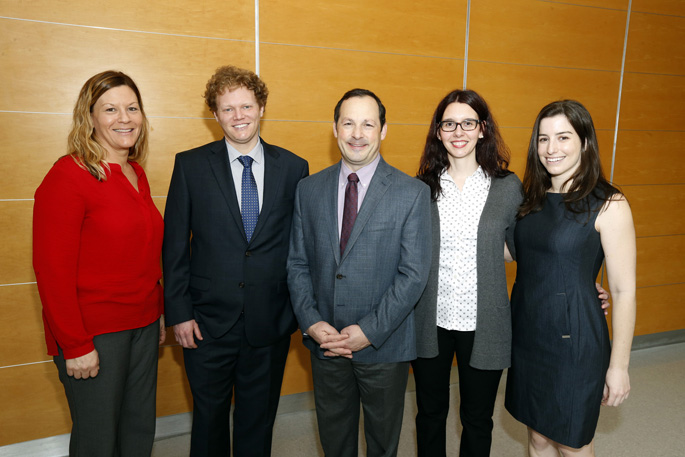
David Calkins, PhD, center, with members of his research team, from left, Wendi Lambert, PhD, Michael Risner, PhD, Melissa Cooper and Silvia Pasini, PhD. (photo by Steve Green)
A team of researchers, led by David Calkins, PhD, vice chair and director of Research at the Vanderbilt Eye Institute, has made a breakthrough discovery in the field of glaucoma showing new hopes for treatments to preserve vision.
In addition, Calkins is encouraged that the findings released in the Proceedings of the National Academy of Sciences (PNAS) will have treatment ramifications to combat age-related neurodegenerative disorders like Alzheimer’s and Parkinson’s diseases.
The paper, “Axogenic Mechanism Enhances Retinal Ganglion Cell Excitability During Early Progression in Glaucoma,” unmasked a revolutionary conclusion — in the past it was believed that as retinal activity is lost, the connection between the retina and the brain should be gone, but the opposite is true.
Calkins deemed the information one of the most significant discoveries since his team showed in 2010 that the first sign of injury in glaucoma occurs in the brain, and was similar to other age-related, central nervous system diseases.
“What we have demonstrated in our most recent study is that the brain fights back,” said Calkins, Denis O’Day Professor of Ophthalmology and Visual Sciences and director of the Vanderbilt Vision Research Center. “And we identified the mechanism for what causes this compensatory response. We found that for a brief period of time this particular mechanism actually preserves vision, despite the onslaught of stress in glaucoma.
“This is a real paradigm shift,” Calkins said. “The dogma has been that once started, neurodegenerative disease is a one-way path. But we found that individual neurons fight back to maintain signaling between brain regions, thereby slowing progression. It’s a balance between disease and adaptation.
“We think we can develop new therapies based on this mechanism to keep the optic nerve signaling, which will maintain vision even as a disease progresses.”
Diseases of the central nervous system involve early degradation of axon function that often precede degeneration — basically as the disease progresses, the retina stops talking to the brain, and soon afterward the axons begin to degenerate, then the retina and finally the brain, explained Calkins.
The team used a model of glaucoma, the leading cause of irreversible blindness in the world, to record and compare how the loss of synapses relates to the diminishment of signals to the axon.
Neurons have specialized projections called dendrites and axons. Dendrites bring information to the cell body and axons take information away from the cell body.
Information from one neuron flows to another neuron across a synapse.
In neurodegenerative disorders of the brain, those synapses are lost as the neuron dies.
Calkins’ team found that the axon signals did not diminish, rather the signaling to the brain increased, meaning that neurons were fighting back against the loss of excitatory activity.
“We discovered a sodium channel that usually sits far away from the cell body of the neuron,” Calkins said. “As the dendrites are lost, the sodium channel moves closer to the cell body and whatever residual activity remains, the channel boosts and amplifies the axon signal to the brain and for a brief period of time this mechanism actually preserves vision.”
“With this information, we hope to bootstrap this natural adaptive mechanism and prolong signaling between brain regions and prevent subsequent degeneration. As long as signaling is maintained, progression slows and vision is maintained.
“Now that we have identified the mechanism that causes adaptation, we can exploit it through new drugs or even gene therapy.”
CLICK HERE TO READ THE PNAS PAPER